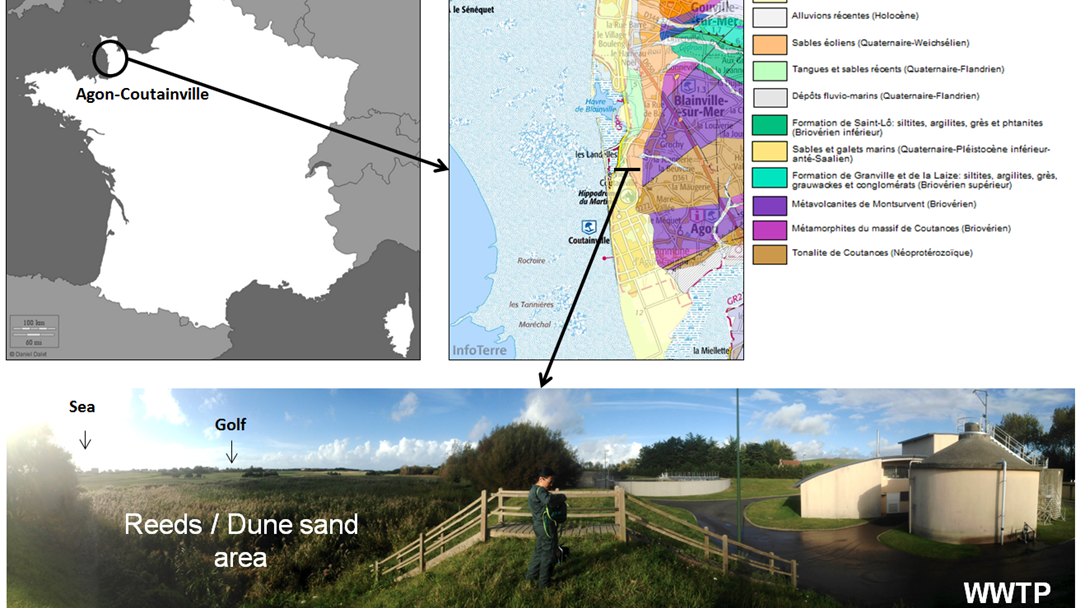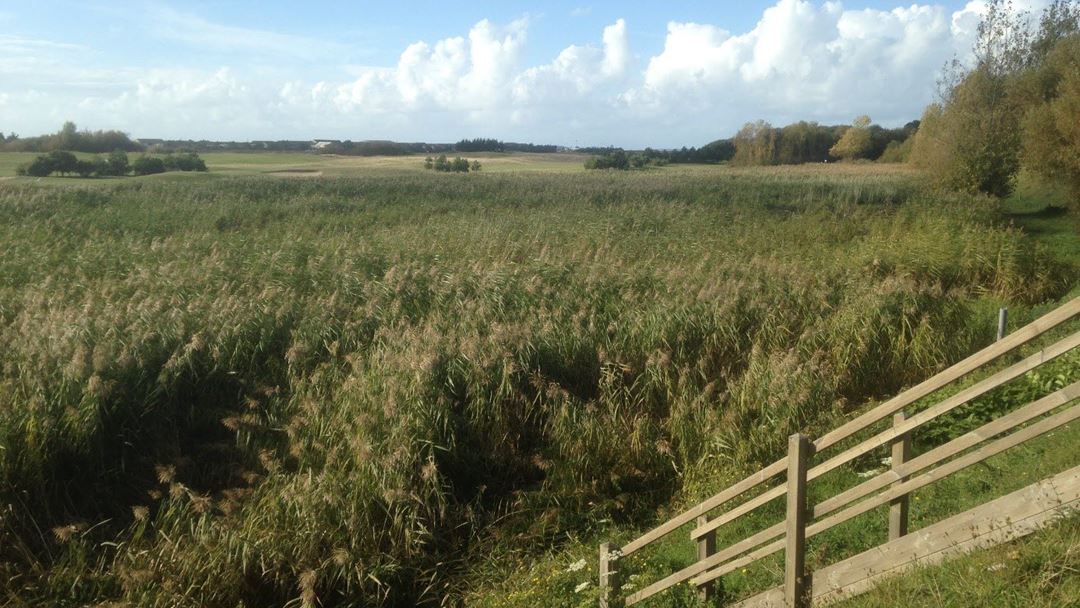Case France
French case study: Managed Aquifer Recharge (MAR) at Agon-Coutainville Waste Water Treatment Plant (WWTP) including activated sludge, reed bed and sand dune filter dune
Exisiting scheme
For more than 20 years in Normandy, small collectivities have preferentially chosen extensive natural systems for wastewater treatment. These treatments include tertiary treatment by wetlands with macrophytes and/or microphytes and sandfilters or reed bedfilters treatment plants as MAR/SAT. The site of Agon-countainville (France) uses secondary effluent (activated sludge) from the wastewater treatment plant going through a reed bed and a sand dune filter (see figure below).
Agon-Coutainville is located along the English Channel coastline and presents a population of 2 922 habitants (INSEE, 2013). According to the geological map of the area, geology of the coastline is composed by a 2m to 10m recent sandy layers which were deposed on and weathered underlying shale basement.
The MAR/SAT system has been preferentially chosen from the conventional French direct discharge system in the water surface (river or sea) in order to protect the sensitive shellfish production zone on the surrounding estuary. The treated water is also used for golf irrigation. The filtration process has good efficiency in microbiological reduction rate with E.Coli generally <100/100ml (i.e. 3 U.log removals) due to a filtration through the reeds area followed by 3 m of vertical dune sand filtration. There are no visible clogging problems when phasing the feeding times of the reed/sand with long periods of rest/draining off.
The nominal capacity of Agon-Coutainville wastewater treatment plant is about 33 500 inh. eq. (inhabitant equivalent) with a nominal capacity of BOD5= 2120kg /day. The activated sludge treatment train in Agon-Coutainville is managed by SAUR. The water stream is composed by pre-screening, pump station, buffer tank, rotative screening, oil and grit separators with sand classifier, two aeration tanks (4000 m3), a 470 m² clarifier, a treated water counting canal and reject to the reed bed area.

Objectives of French case study
Applied and optimize this ICT tool with the strong implication of stakeholders, namely SAUR (comprehensive delegated management of public services for local authorities), Seine Normandy Water Agency (Public Institution of the Ministry of Ecology whose mission is to support the actions of water resources protection), and ARS (Regional Agency of Health) with project partners as GeoHyd (pivate company, Antea), and ProjecSt cientific institution as BRGM (French Geological Survey).
Extend the impact of such Nature based solution practice at a larger scale of the watershed catchment (actually, this coastal area is threatened by a huge number of WWTP discharges without optimisation of the treatment train, see figure below) applying a ESS evaluation framework to the Agon WWTP and compared to others local WWTP
State of the art, innovation envisaged and ambition for improvement
Managed Aquifer recharge (MAR) for water reuse applications is rapidly growing last decade (Lazarova et al., 2011) in order to face the deterioration of groundwater quality and the decreasing groundwater quantity (Kazner et al., 2012). Non-conventional water source for MAR containing chemicals, both endogenous and anthropogenic, have the potential to enter the aquifer environment from surface systems. Pre-treatment for MAR is necessary to enhance system performance and efficiency, to remove critical contaminants (pathogens, ammonia, trace metals…) from the source water, to ensure the long term system performance and to meet regulatory demands. Methods that are commonly used for pre-treatment for MAR are sedimentation, filtration and disinfection to avoid clogging of the system. Further pre-treatment processes for a large range of contaminants removal include micro-sieving, skimming, dissolved air flotation, decantation, coagulation and flocculation, activated sludge, biofilters and wetlands (Van der Hoek et al., 2000; Balke & Zhu, 2008; Dillon et al., 2009).
Soil Aquifer Treatment (SAT) is a natural extensive treatment using the physical and biogeochemical properties of the vadose zone and aquifer for water quality improvement as tertiary treatment for secondary effluent (Amy and Drewes, 2007; Wei et al., 2016). This is a treatment system with low operating cost and stable performance (K. He et al., 2016). Inorganic pollutants as heavy metals and hazardous ions can be removed as well as organics and pathogens during the water recharge process (Reemtsma et al., 2010). Recently, a particular attention has been paid about the detection, attenuation, and fate of contaminants of emerging concern (CECs) (e.g., pharmaceuticals, household chemicals) as well as pathogens and antibiotic-resistant bacteria and genes (Pal et al., 2010; Regnery et al, 2015; Regnery et al., 2016).
